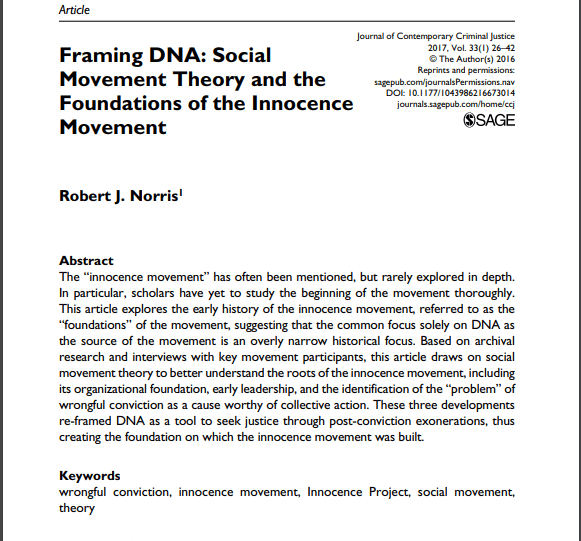Framing DNA: Social Movement Theory and the Foundations of the Innocence Movement by Robert J. Norris

| Title | Framing DNA: Social Movement Theory and the Foundations of the Innocence Movement by Robert J. Norris |
| Author | Robert J. Norris About Author Robert J. Norris is an Assistant Professor in Criminology, Law, and Society at George Mason University. He holds a BA in Sociology from UNC-Greensboro and both an MA and PhD from the University at Albany’s School of Criminal Justice (SUNY). His research focuses on the social and political aspects of legal reform, legal decision-making, public opinion, wrongful convictions, and criminal admissions. Dr. Norris has contributed to various academic articles and book chapters in these fields and has authored or co-authored three books: *When Justice Fails: Causes and Consequences of Wrongful Convictions* (with C. Bonventre and J. Acker, CAP, 2018), *Exonerated: A History of the Innocence Movement* (NYU Press, 2017), and *Examining Wrongful Convictions: Stepping Back, Moving Forward* (co-edited with A. Redlich, J. Acker, and C. Bonventre, CAP, 2014). He has also served on the Professional Board of Editors for the Annual *Miscarriages of Justice* issue of the *Albany Law Review* and is a founding editorial board member of the *Wrongful Convictions Law Review*. |
| Overview | The article discusses the complex history and current state of Indian education in the United States, emphasizing the importance of preserving Native American culture and language as a means of maintaining tribal sovereignty. It provides a comprehensive overview of how federal Indian education policies have evolved from attempts at assimilation to more recent efforts aimed at supporting the unique educational and cultural needs of Native American students. Here’s a brief summary of the key points: Historical Context: Indian education policy initially mirrored broader federal policies aimed at assimilating Native Americans into mainstream society, often at the expense of their culture and language. The boarding school era, where Native children were removed from their families and communities, exemplifies these efforts to “kill the Indian, save the child,” eradicating native languages and cultures. Current Federal Indian Education Policy: Despite the historical push for assimilation, modern policies recognize the federal government’s trust responsibility to provide quality education tailored to the cultural needs of Native American students. Key legislation includes the Indian Education Act of 1972 and Title VII of the No Child Left Behind Act, which provide funding and support for programs that address the unique needs of Native American students. Challenges and Proposals: The article discusses the ongoing challenges faced by Native American students, including the risk of language extinction and the threat this poses to tribal sovereignty. It also touches on recent legislative efforts and debates, such as the proposed HR 5 bill, which faced criticism for potentially undermining federal support for Native American education. This comprehensive analysis underscores the importance of culturally responsive education in preserving Native American identity and sovereignty. |
| Download Link | click here to download |